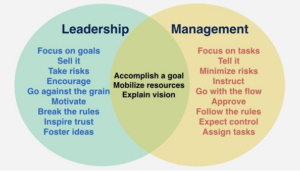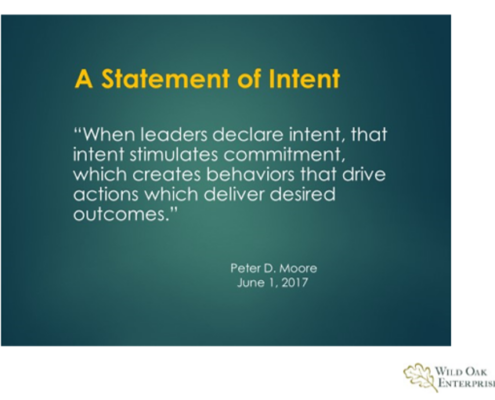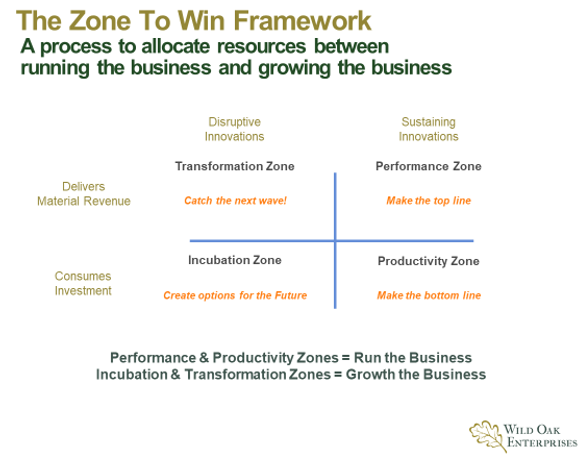
March 27, 2024
In the digital world,
Success is about distinguishing between leadership & management

Is your management agenda holding your leadership agenda hostage?
Almost every C-level executive I speak with tells me they are so busy running their business that they have no time to think about the best ways to grow their business. In KPMG’s Global CEO Outlook survey of 400 CEOs, 85% “admit vulnerability about the amount of time they have to spend strategizing about the forces of disruption and innovation.”
The most effective leaders I’ve worked with have been very adept at distinguishing what’s important from what’s urgent and spending the majority of their time on the former rather than the latter.
When most leaders define their critical priorities and desired outcomes, they combine run-the-business deliverables with grow-the-business deliverables. My contribution to this process is to help them develop and separate these priorities. In doing so, it protects them from letting their management agenda hold their leadership agenda hostage.
Leaders need to privilege long term growth over short term performance
In a time of unprecedented change and disruption, it is easy to focus on short-term problems, try to preserve what you have, and survive to fight another day. The big “aha” moment for senior leaders occurs when they realize that short-term performance consumes long-term growth. This means that if the company continues to overweight investments in current businesses to deliver short-term performance, it will eventually liquidate the company’s long-term power to grow.
To avoid that trap, senior leaders must clearly define and differentiate their leadership agenda. Where do they want to break new ground for long term growth? Where do they want to see significant improvement in their current operations? This also allows leaders to openly communicate their desire to devote the majority of their time to their leadership agenda while relying on their management team to deliver the results of their operating agenda.
Successful leaders start with a clear statement of strategic intent to accelerate business growth momentum?

As companies of all sizes across all industries seek to successfully compete as digital enterprises, there is solid evidence of what separates success from failure. It turns out that the early leaders in the age of digital disruption share one thing in common – a clear statement of strategic intent. This intent is the primary source of sustainable business growth momentum.
In the slide above, I have summarized what I think a statement of intent encompasses: When leaders declare intent, that intent stimulates commitment, which creates behaviors that drive actions which deliver desired outcomes.
Zone Leadership Framework: Segmenting the leadership agenda from the management agenda
In working with multiple C-Suite leaders, I’ve found our Zone To Win framework to be an invaluable process and tool to help identify and segment leadership agendas from management agendas. The key point of differentiation is:
- Their management agenda is where they want to see measurable performance improvement in their existing operations
- Their leadership agenda where they want to break new ground.
Here are how those discussions have played out over the 4 zones:
Run the Business- Management Agenda Zones
Productivity Zone: This zone contains all the company’s shared services and cost centers including IT, Legal, Finance, Security, HR, and others. Each of these operating functions are essential to running the company and supporting the existing businesses in the performance zone.
The management challenge for this zone is to continually look for opportunities to identify and release trapped value in legacy systems of record and operating processes. Once released, these resources and budget can be redeployed against grow the business initiatives.
To ensure success here you want to install a collaboration culture led by an empathy-oriented leader who inspires the team to be of service to others. He or she must be vigilant in maintaining the quality, integrity, and security of the company’s systems of record while at the same time being sensitive to the pressures the performance team is under. It is critical to deploy a strong demand management/capacity planning governance tool to make sure that it can deliver on the commitments it makes to the performance zone.
Performance Zone: This zone contains all the current business units that deliver the short-term revenues, margins, and profits for the company. The management challenge for this zone is to gain alignment and commitment from both the different business units and the necessary support functions in the productivity zone to meet or exceed the goals and deliverables in the annual plan.
To ensure success here you want to install a performance culture led by a results-oriented leader who measures outcomes objectively and holds people accountable to their committed metrics. The metrics themselves relate directly to how digital technology drives new revenues, margins, and profits. The leader should know the business well and hold their entire team accountable to achieving the company’s business growth goals and financial targets.
Grow the Business: Leadership Agenda Zones
Incubation Zone: This zone is where you want people to look beyond your current charter and processes to identify new digital technology products, services, and businesses that enable your company to successfully grow and compete as a digital enterprise.
To ensure success, you want to install an innovation culture that will challenge the status quo, inspire creativity, and generate game changing ideas. Here the key metrics are speed to market and time to value driven by an iterative fail-fast development model.
Transformation Zone: This zone is where the organization commits to using digital technology to launch a net-new revenue engine that will scale to 10% or more of the company’s overall revenues. It also includes initiatives to enter adjacent markets to your current markets, as well as merger & acquisition opportunities.
To ensure success you need to install a command culture led by the CEO and Board of the company as the stakes of success or failure are too high to be delegated elsewhere in the C-Suite. The leadership role here is to help make the compelling business case that the necessary investments in the new digital technologies will generate exponential growth and a higher return than the cost of capital.
By deploying the 4 Zones framework, CEOs and other C-suite leaders can effectively and efficiently identify, segment, and clearly communicate their leadership agenda from their management agenda. That enables them to reprioritize their time and focus on what they will be directly involved in implementing their leadership agenda while delegating and overseeing the implementation of their management agenda to their direct reports.
|





